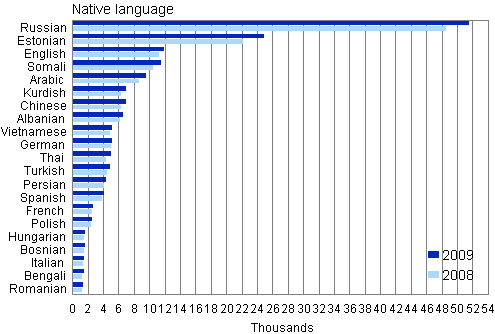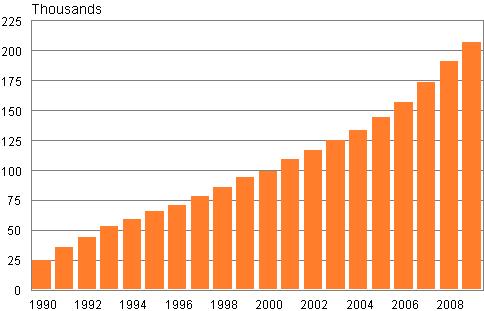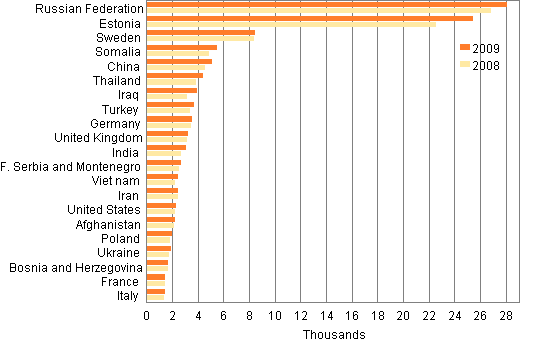1. Review of the population structure of Finland 2009
1.1. Native language
At the end of 2009, the number of foreign-language speakers in Finland was 207,037, which includes an increase of 16,499 from the previous year. The number of foreign-language persons has doubled during the past nine years. Figure 1 shows the groups of over 1,500 foreign-language speakers in 2009 and the same language groups in 2008.
Figure 1. Largest groups by native language in 2008 and 2009

Compared with the previous year, new foreign-language groups with over 1,000 speakers were speakers of Bulgarian, Japanese, Ukrainian and Urdu. There are now 30 different foreign-language groups with at least 1,000 speakers in Finland. The sizes of all the largest language groups shown in the figure 1 grew during 2009. Speakers of Russian make up the largest foreign-language group in Finland. Russian-speakers in Finland today number 51,683 and their share of all the foreign-language speakers in the population is 25 per cent.
Figure 2. Number of foreign-language speakers in Finland in 1990–2009

Relative to the population the shares of foreign-language speakers are the highest in Uusimaa at 7.7 per cent and Åland at 4.8 per cent. The number of foreign-language speakers is the lowest in South Ostrobothnia where their share of the population is only one per cent.
Examined by municipality, the share of foreign-language speakers is the highest in Oravainen where 10.4 per cent of the population are foreign-language speakers. Helsinki has the second highest respective share of 10.2 per cent. In twelve municipalities in Finland the share of foreign-language speakers exceeds five per cent of the population. In 126 municipalities their share is under one per cent.
1.2. Citizenship
A total of 97.1 per cent of the population of Finland are also Finnish citizens. At the turn of the year, 155,705 foreign citizens resided permanently in Finland. This is 12,449 more than twelve months previously. In all, the foreigners resident in Finland represent 172 nationalities. However, they also include persons with former citizenships of e.g. the Soviet Union, Republic of Yugoslavia and, as the most recent one, Serbia and Montenegro.
Figure 3. Largest groups of foreign citizens in 2008 and 2009

The age structure of the foreign citizens living in Finland is notably younger than that of the native population. At the end of 2009 the average age of men among the foreign citizens was 33.7 and that of women 34.5 years. The respective average ages among the total population were 39.8 years for men and 42.7 years for women.
The demographic dependency ratio among the foreign citizens was 24.2 (50.6 for total population) and as many as 80.5 per cent of the foreign citizens belong to the working-age population, that is, are aged between 15 and 64. The growth in the number of the foreign citizens is not solely due to new immigrants. For example, a total of 1,871 foreign citizens were born in Finland in 2009.
The native language of eight per cent of the foreign citizens (13,049 persons) is Finnish, Swedish or Saami. On the other hand, 64,381 Finnish citizens have a native language other than Finnish, Swedish or Saami. In 2003, Finland adopted a law that allows dual nationality. A foreign citizen no longer loses the citizenship of his/her native country when being granted Finnish citizenship. At the end of 2009, there were over 50,000 persons resident in Finland who held the citizenship of some other country in addition to Finnish citizenship. In statistics these persons are classified as Finnish citizens.
Source: Population Structure 2009, Statistics Finland
Inquiries: Markus Rapo (09) 1734 3238, vaesto.tilasto@stat.fi
Director in charge: Jari Tarkoma
Updated 30.9.2010
Official Statistics of Finland (OSF):
Population structure [e-publication].
ISSN=1797-5395. Annual review 2009,
1. Review of the population structure of Finland 2009
. Helsinki: Statistics Finland [referred: 19.1.2026].
Access method: http://stat.fi/til/vaerak/2009/01/vaerak_2009_01_2010-09-30_kat_001_en.html

